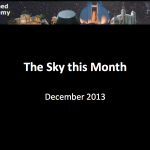December 8, 2013
Sky this Month: December 2013
 by Mike Meynell
by Mike Meynell
Here is a list of objects to view in the sky in December 2013:
- Comet C/2012 S1 ISON. Unfortunately, the comet seems to have completely disintegrated. We may see a meteor shower in early-mid January. However Comet C/2013 R1 (Lovejoy) is well placed in pre-dawn skies.
- Venus is an evening object, about magnitude -4.6, so by far the brightest object in the sky, apart from the Moon – 6 times brighter than Jupiter at magnitude -2.5. It is about 25% lit at the moment, so a beautiful crescent shape to look at in a telescope.
- Jupiter is situated about 60 degrees high above the horizon in Gemini, it is a magnificent sight at around magnitude -2.5. It reaches opposition on 5 January, so we will be seeing it at its best over the next couple of months. As ever, watch out for the Galilean moons, which can be easily seen through a telescope or even binoculars. There are lots of shadow transits that you can view throughout the month.
- The Geminids meteor shower is on 13/14 December, radiating from near the bright stars Castor and Pollux in the constellation Gemini. Unfortunately, the Moon will get in the way of viewing, so best to look after the Moon sets on 14 December at around 5am.
- The Winter Circle is a large asterism, which is composed of eight of the brightest stars in the Northern hemisphere’s winter sky. The asterism extends over 60 degrees across the sky. The stars are (in anti-clockwise order) Capella, Menkalinan, Castor, Pollux, Procyan, Sirius, Rigel, and Aldebaran.
The presentation is shown in the video below. Watch it full screen to see the star maps clearly. Press the spacebar to pause and restart the video. If the video is not displayed correctly below, watch it on Vimeo here.
.
Posted under: Flamsteed, Sky This Month

You must be logged in to post a comment.